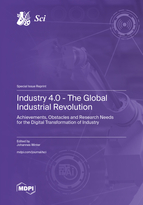Industry 4.0 – The Global Industrial Revolution: Achievements, Obstacles and Research Needs for the Digital Transformation of Industry
A special issue of Sci (ISSN 2413-4155). This special issue belongs to the section "Computer Sciences, Mathematics and AI".
Deadline for manuscript submissions: closed (31 August 2023) | Viewed by 43363
Special Issue Editor
Interests: artificial intelligence; data science; industrial AI; industry 4.0; business models; SME
Special Issues, Collections and Topics in MDPI journals
Special Issue Information
Dear Colleagues,
The first three industrial revolutions were triggered by mechanization, electricity, and IT. The transition to hyperconnected, smart, decentralized, and autonomous systems is characteristic of the fourth industrial revolution, in short Industry 4.0. In this way, the increased complexity is to be mastered and a central promise is to be realized: individual products and services that offer a unique value proposition and a superior user experience that are manufactured under the cost-efficient conditions of mass production.
A revolution always battles with the “old” world. Industry 4.0 is extending the analogue and physical world to a digital environment. In this context, revolution means that system boundaries are expanded not only physically but also virtually. Smart factories are equipped with countless sensors, operate in a highly automated manner, and can organize themselves autonomously. Intelligently, the systems are constantly working to optimize productivity and quality. This is made possible by cyberphysical systems and the intelligent networking of machines, products, and workforces. The product itself communicates the information needed for production to the smart factory—and this information is used to control the individual production steps until the desired end result is achieved.
The integration and operation of Industry 4.0 solutions creates unimagined new opportunities, but also new challenges and obstacles in the digital transformation of the organization and the value network.
This Special Issue addresses the achievements, obstacles, and research needs in the field of Industry 4.0 from a scientific and practical perspective.
Dr. Johannes Winter
Guest Editor
Manuscript Submission Information
Manuscripts should be submitted online at www.mdpi.com by registering and logging in to this website. Once you are registered, click here to go to the submission form. Manuscripts can be submitted until the deadline. All submissions that pass pre-check are peer-reviewed. Accepted papers will be published continuously in the journal (as soon as accepted) and will be listed together on the special issue website. Research articles, review articles as well as short communications are invited. For planned papers, a title and short abstract (about 100 words) can be sent to the Editorial Office for announcement on this website.
Submitted manuscripts should not have been published previously, nor be under consideration for publication elsewhere (except conference proceedings papers). All manuscripts are thoroughly refereed through a single-blind peer-review process. A guide for authors and other relevant information for submission of manuscripts is available on the Instructions for Authors page. Sci is an international peer-reviewed open access quarterly journal published by MDPI.
Please visit the Instructions for Authors page before submitting a manuscript. The Article Processing Charge (APC) for publication in this open access journal is 1200 CHF (Swiss Francs). Submitted papers should be well formatted and use good English. Authors may use MDPI's English editing service prior to publication or during author revisions.
Keywords
- Industry 4.0
- smart manufacturing
- smart factory
- digital transformation of industry
- automation
- digitalization
- customization
- business model innovation
- smart services





